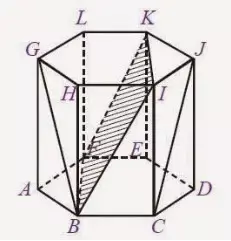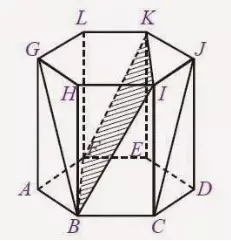Hexagon Prism: Characteristics, Formulas, Point Side Ribs
Loading...
In Mathematics lessons, you will find material about shapes that are more complex than flat shapes, because shapes have a base area and volume. One of the geometric shapes is a hexagon prism.
In addition, there are other shapes, such as cubes, blocks, pyramids, tubes, and so on. This time, we will discuss a prism that has a hexagon-shaped roof and base, starting from its definition, characteristics, to formulas and examples of problems.
List of contents
Definition of Hexagon Prism

This prism is a three-dimensional space structure that has a hexagon-shaped base and roof. This prism also has a blanket with a rectangular shape on the side.
Types of Hexagon Prisms
Prisms themselves have various types, but for hexagons there are two different types based on their shape, namely as follows.
1. Regular Hexagon

A regular hexagon prism is a prism with sides that are the same length and have six angles that are the same size. This means that each side of the prism has the exact same length.
From the picture, you can see that a hexagon can form six equilateral triangles, in where when the central angle (360 degrees) is divided equally into six, then the measure of each angle is 60 degrees.
2. Irregular Hexagon
An irregular hexagon prism is a prism with two sides that are not the same length as the other sides. This makes the angles formed on the prism are also not the same size so it has a slightly complicated way to calculate them.
Read: Geometry
Hexagon Prism Characteristics

The properties or characteristics possessed by this prism are as follows.
- It has 18 ribs, of which 6 are upright ribs.
- Has 12 corner points.
- It has 8 sides, where the 6 sides that are on the side are rectangular sides, while the other 2 sides are on the roof and base, in the form of a hexagon.
Rib of Hexagon Prism
The first element of a hexagonal prism is the edge. As previously explained, a hexagon prism has 18 edges, of which 6 are upright edges. Look at the image below.

In the image of the hexagonal prism, the edges are AB, BC, CD, DE, EF, FA, GH, HI, IJ, JK, KL, and LG. While the upright ribs are AG, BH, CI, DJ, EK, and FL.
Read: Build Curved Side Room
Sides of a Hexagon Prism

The elements that the next hexagon has are the sides. In the previous image, it can be seen that this spatial structure has 8 sides or planes, including the following.
- ABCDEF, as the side of the base.
- GHIJK, as the upside.
- BCIH, as the front side.
- FEKL, as the back side.
- ABHG, as the right front side.
- AFLG, as the right back side.
- CDJI, as the left front side.
- DEKJ, as the left rear side.
In this faceted prism also has a diagonal plane or side diagonals that add up. Look again at the picture above, the diagonals of the prism are BG, CJ, BI, AH, HC, ID, DK, JE, KF, LE, LA, GF, HK, IL, BE, and CF.
In addition, in a polygonal prism there is a so-called diagonal plane. According to the picture, the four diagonal planes of the prism are BFKI, ECHL, KLBC, and HIEF.
The space diagonal is also an element in a prism with a hexagon. Based on the picture, there are 36 diagonal spaces there, and nine of them are AI, AJ, AK, BJ, BK, BL, CG, CL, CK, and so on.
Angle Point of Hexagon Prism

Still talking about the elements of a hexagonal prism, the next element is the vertex. This prism has 12 vertices. When looking at the previous image, the corner points are A, B, C, D, E, F, G, H, I, J, K, and L.
Read: Build a Flat Side Room
Hexagon Prism Formula

Build this three-dimensional space can be calculated surface area and volume with different formulas. You can listen to the formulas as follows.
1. Calculating Surface Area and Volume
To be able to work on problems related to the shape of a prism with a hexagon base, you can study the following formulas.
a. Formula for Surface Area of Prism with Regular Hexagon
Can be calculated by the following formula.
L = 2La + Ls
Where La is the area of the base of the prism and Ls is the blanket.
For a regular hexagon, the formula for the area of the base is as follows.
La = 3/2√3. s2
Where s is the side length of the regular hexagon.
For a regular hexagon, the formula for the area of the blanket is as follows.
Advertisement
Ls = Ka. t
Where Ka is the perimeter of the base and t is the height of the prism.
b. Prism Volume Formula with Regular Hexagon
Can be calculated by the following formula.
V = La. t
Where V is the volume of the prism, La is the area of the base, and t is the height of the prism.
2. Problems example
Now, after mastering the formulas, you can test your abilities with some sample questions. Here we present examples of work and solutions.
a. Example Question 1
A prism has a base with a regular hexagon shape. If the length of the side of the base is 10 cm and the height of the prism is 7 cm, what is the volume of the prism!
Solution:
V = La. t
V = 3/2√3. s2. t
V = 3/2√3. 102. 7
V = 3/2√3. 100. 7
V = 1050√3 cm3
b. Example Question 2
There is a prism with a regular hexagon base with a volume of 576√3 cm^2 and a height of 6 cm. What is the length of the side of the hexagon?
Solution:
V = La. t
576√3 = La. 6
576√3 = 3/2√3. s2. 6
576 = 3. s2. 3
576 = 9. s2
S2 = 576 / 9
s2 = 64
s = 8 cm
c. Example Question 3
A prism has a regular hexagon base with a side length of 15 cm and a height of 10 cm. Calculate the surface area of the prism!
Solution:
L = 2La + Ls
L = 2(3/2√3. s2) + (6. 15. 10)
L = (3√3. s2) + 900
L = (3√3. 152) + 900
L = (3√3. 225) + 900
L = 675√3 + 900 cm2
d. Example Question 4
A prism with a regular hexagon base has a surface area of 300 3 + 480 cm^2 and a side length of 10 cm. How tall is the prism?
Solution:
L = 2La + Ls
300 3 + 480 = 2La + Ls
300 √3 + 480 = 2(3/2 √3. s^2) + (6. 10. t)
300 √3 + 480 = (3 √3. 10^2) + 60t
300 √3 + 480 = (3 √3. 100) + 60t
300 3 + 480 = 300 3 + 60t
300 3 + 480 – 300 3 = 60t
480 = 60t
t = 8 cm
Practicing with the material and working on problems related to hexagon prisms can hone your skills. Although it is more difficult than working on a flat shape, the more you practice, the more accustomed you will become to solving more problems.
X CLOSE
Advertisements
ADVERTISEMENT
X CLOSE
